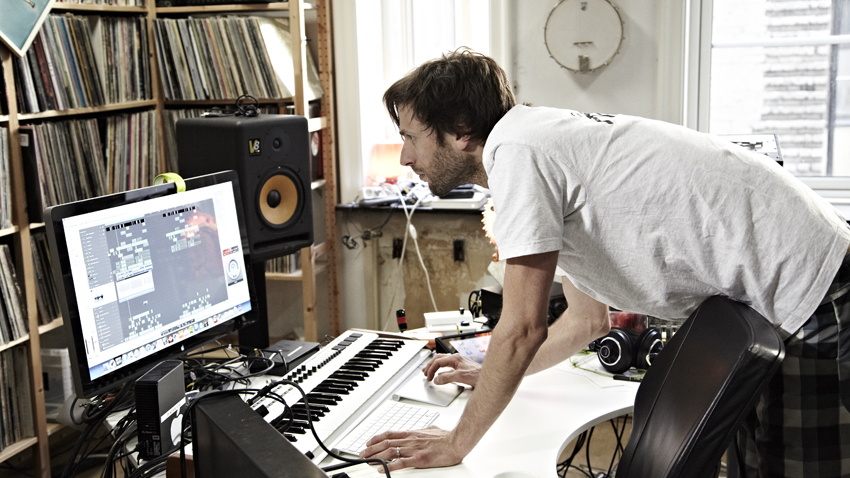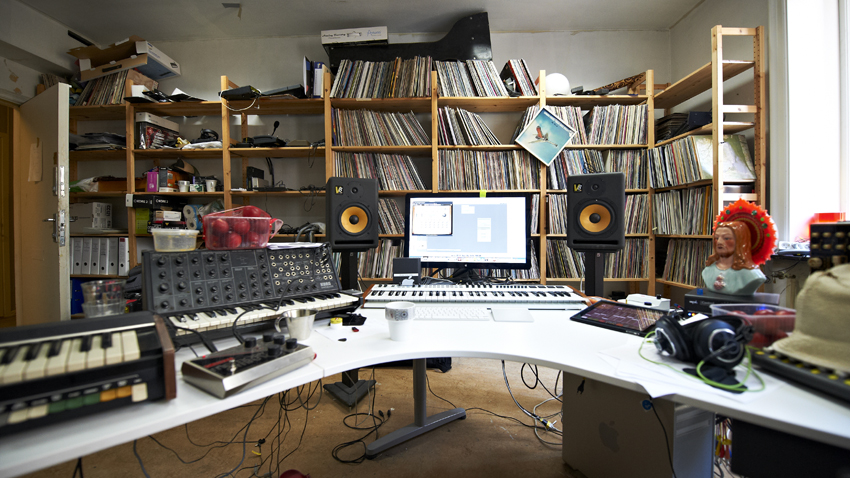Lindstrom in the studio, interview and video tour
Future Music see the gear and technique in his old-meets-new studio
Lindstrøm has been one of the most consistent artists in Electronic music over the past decade. From 20-minute sonic treks to classic Pop collaborations, Prog-inspired remixes and sequenced dancefloor gems, Hans-Peter has taken a hugely varied approach to making music, following his heart and leaving a rich discography in his path.
Manoeuvring through a shoulder-width staircase, we made our way to his workspace, littered with vinyl, effects pedals, cables, gear and kitsch charity shop ornaments. The blend of old and new and the organised chaos of the studio perfectly reflects the music that flows from it and after a quick tour, Future Music sat down to talk.
See the full size studio gallery with Lindstrøm here
What were your first experiences with Electronic music?
"When I was younger, I used to be in bands that played everything from Heavy Metal to Country! I remember I bought a triple Ninja Tune compilation to try and find out what club music was all about. I bought a sampler and was trying to copy what DJ Food and Amon Tobin were doing in the late '90s. All I had was a sampler, a MIDI controller and some speakers and I spent a lot of time in front of that sampler - an E-mu e6400. A friend told me that you could hook that sampler up to a computer and sequence it from there instead and a few years later I was just using [NI] Kontakt instead."
"Usually when I put out an album, there's already a new album finished or close to being finished."
What made you start your own label?
"A few years before I did that, I was working with a guy in Oslo releasing my music. After a while I realised we didn't need two people to work on it, and that I could do it myself. In the beginning I was just making music and burning CDs and gave them to DJs who came to Oslo. I also managed to print 500 12-inches as promo and sent them out. I believed that if the music was strong enough, someone would pick it up sooner or later. I did that gave me passion to go back into the studio. The second 12-inch I asked Prins Thomas, who I'd just met, to do a remix and it actually ended up being one of the Christabelle tracks. I met more and more people, started to travel, got a booking agent and it just built from there. It was really slow though, over a number of years. I really believe in building slowly and I'm really glad I did my own label first, just to learn how the business works."
Speaking of Prins Thomas - you, him and Todd Terje all have a very defined sound...
"I've known Terje for more than ten years. We share a lot of the same musical preferences. If one of them makes a really good song then I'm thinking 'I'm going to make a song that's even better' and they are probably thinking the same, so there's some friendly competition. For some reason we all ended up in the same studio building. I'm still collaborating with Prins Thomas - we're working on some new stuff and we've done two remixes together. It's really handy to just knock on his door and have a listen to what he's doing."
And Todd Terje mixed Smalhans right?
"Yeah, he's really getting into the nerdier eningeering side. The difference is that he's a DJ too so he knows how to make it sound good on a big system. Some people who mix for a living, it feels like they'reworking on an assembly line. Two days and it's done and they're just going through the motions. With Terje, he took it very seriously and spent like a month and a half on it. I'm really happy with what he did. It's funny because the tracks on Six Cups of Rebel that came out early last year and Smalhans were all finished at the same time but I realised the sound was too different so I wanted to split them up.
"Usually when I put out an album, there's already a new album finished or close to being finished. I hate the idea of releasing something and not having any plans for afterwards. I usually get working straightaway and even right now I'm working on two more albums."
Get the MusicRadar Newsletter
Want all the hottest music and gear news, reviews, deals, features and more, direct to your inbox? Sign up here.

How does that affect your live sets?
"I only play my own music when I'm playing live, so I don't have that much to choose from. Some of the stuff I've been releasing over the years has been maybe more down-tempo or a bit weird for a festival setting. It's good to have limitations sometimes, but I do wish I had more simple and minimal stuff to play. When I'm making music, I usually pay a lot attention to details, but in a club or in a festival, no one notices those things really."
After those types of gigs, do you find yourself stripping it back when you return to the studio?
"Yeah sometimes - I don't consider that a bad thing though. The fact that I'm playing in clubs and festivals is definitely affecting the kind of music I'm making. Sure you think 'This will work in a club; this will not work in a club' when you're working on something. The album with Christabelle [Real Life is No Cool] and the album the before that, Where You Go I Go Too, I recently found myself wanting to do more club-friendly music.
"Having said that, even though I do different kind of stuff, it really is just one sound - I wouldn't even be able to do anything different if I wanted to because it's all from my head. Even the club stuff is still based on melody, chord changes and flow, rather than being really bangin'. When I stopped doing the simpler, more club stuff it was only because I was tired of working on it. But now everything sounds different because of what I've been doing in the mean time, so it was really fun to go back to that again [on Smalhans]."
Do you find it hard to finish tracks, because you work across so many different styles?
"Yeah! [laughs] It's really hard. It's so easy to start a track. Maybe I'll spend two weeks on one track, and two hours of that is basically the track done. The rest is arrangements and sounds."
How do you usually get over the hump?
"I just have to spend a lot of time on it really. And that's all before the mixing process too. I mean, when I give a track to whoever is mixing it, it doesn't actually need to be 'mixed' in the traditional sense. There's nothing creative to do at that point, it's just some of the more scientific stuff and to get it ready for mastering."

Is it tough to let go of creative control? Producers who work alone tend to be control freaks!
"Yeah it's taken years. When I first started I did as much myself as possible. Back then I did the label stuff [Feedelity Records], the marketing, emailing, MySpace, office admin and I wasn't making music. After a while, I got in touch with Joakim from Smalltown [Supersound] and he really wanted to do something. At first I was just releasing tracks but then I became one of their artists. Then I got a manager and was able to hand over the accounting stuff. I decided I wanted to give away mixing to someone else too."
Were you surprised about how well Where You Go I Go Too was commercially received?
"I was very surprised! It was released in 2008 and by that point it was possible to listen to a lot of musicand consume it very fast. I thought Where You Go I Go Too was more of a special-interest product that only certain people would be interested in. I got a lot of help from Pitchfork and The Guardian - I guess the sound was different and that's what makes you stand out."
"I like to have one foot in the future and one foot in the past."
What were the main synths and sounds on that LP?
"Very similar to what I'm using now, which is a mix between digital and analogue. I was using Cubase then so there were a bunch of VSTs from that and a plug-in called [Steinberg] Plex. I don't think it exists anymore but I was using that a lot. I'd just started buying new things when I was making that album. I got a Memorymoog and re-bought a [Roland] Juno-60 that I had to sell before! For a lot of the arpeggiator stuff I was using a Kenton MIDI-to-CV converter and recording sounds from those synths. It was a mixture between VST and real instruments."
Did you press record and start jamming or did you write the songs before you recorded?
"I was just jamming and playing around with chord changes. Then I just decided on the main themes and incorporated everything else around those. I was doing the Christabelle album at the same time. I really like Pop music and I really like working with vocals, but I also want to do more experimental things so it worked really well for me to do both at the same time. I get bored quickly, so I need to have that dynamic."
Real Life Is No Cool was a huge contrast and sounded like a live band. Did you record for that or was it a mix of in and out of the box?
"I recorded it all. I got help from Knut [Sævik, Mungolian Jet Set] who mixed that album, and Where You Go I Go Too. I played everything on that, the only thing that happened when it got to the mix part was that he wanted to add some real horns - I think he wanted it to sound like Quincey Jones. Before that it was just a brass poly synth playing the same thing. To be honest, I didn't really like the horns and wanted to change my mind at the end, but it was too late!"
And that was in Cubase too? What were the main instruments?
"Yeah. I played a lot of guitar and bass on it, and I used the [Suzuki] Omnichord a lot. I'm using Logic now and it's really easy working within Logic for arrange and compose but everything you do in the box sounds a bit sterile. So when it's all done, I like to replace the soft synths with real sounds and also add some textures on top, even if it's just a badly-mic'd organ, just to give it some air. I'm not crazy about going retro or working exactly as they did in the '70s or the '80s but at the same time, I'm not completely digital and futuristic. I like to have one foot in the future and one foot in the past."


Future Music is the number one magazine for today's producers. Packed with technique and technology we'll help you make great new music. All-access artist interviews, in-depth gear reviews, essential production tutorials and much more. Every marvellous monthly edition features reliable reviews of the latest and greatest hardware and software technology and techniques, unparalleled advice, in-depth interviews, sensational free samples and so much more to improve the experience and outcome of your music-making.










